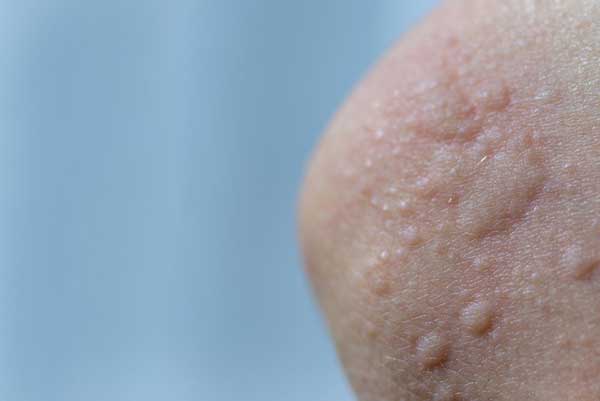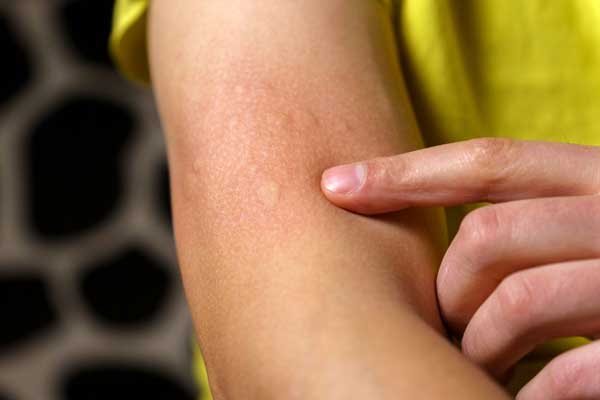Hives, also known as urticaria, are an outbreak of swollen, red, bumpy rashes that appear on the surface of the skin either as the body’s reaction to allergens or for unknown reasons. This intensely itchy rash marked by hives can spread across large areas of the body and may also burn and sting.
Hives can appear anywhere on the body, including the ears, arms, hands, fingers, legs, feet, and toes. They vary in size and shape and may join together to form larger raised areas known as plaques.
Typically lasting a few days, hives do not leave any long-lasting skin changes. About 20% of people are affected by hives at some point in their life. Hives are not contagious.

Types of Hives
There are several types of hives:
Acute Urticaria
Acute urticaria refers to hives lasting less than six weeks. They may occur as the result of an adverse or allergic reaction to certain foods, medications, insect bites, or infections. Acute urticaria occurs equally in males and females and is more common among children.
Chronic Urticaria
Chronic urticaria refers to hives lasting longer than six weeks. Unlike acute hives, the cause is usually more difficult to identify. However, chronic hives may result from an underlying condition like cancer, infection, thyroid disease, or hepatitis. This more severe form can affect different body systems like the lungs, digestive tract, and muscles. Chronic hives are more common in middle-aged women.
Physical Urticaria
Physical urticaria refers to hives caused by skin irritation from sources like extreme heat or cold, excessive sweating, overexposure to the sun, or scratching. Dermatographic urticaria is a form of physical hives caused by scratching or firm stroking of skin.
Causes
Hives occur when the body reacts to an allergen, releasing high levels of histamine and other chemicals into the skin. In response, blood vessels dilate, become more permeable, and start leaking fluid into tissues, resulting in swelling and itchiness.
Many substances can trigger hives, including:
- Foods: nuts, wheat, eggs, strawberries, shellfish, food additives
- Physical stimuli: pressure, temperature extremes, sun, exercise
- Medications: codeine, ibuprofen, penicillin, blood pressure medications
- Infections: flu, cold, hepatitis B
- Allergens: pollen, dust mites, insects, latex, pet dander, plants
- Skin irritation from sweating or heat
- Stress
- Underlying conditions like thyroid disorders
Symptoms
The main symptoms of hives include:
- Raised, itchy red or pink bumps
- Rash appearing in multiple places, disappearing and reappearing
- Each outbreak lasts minutes to hours

Diagnosis and Treatment
To diagnose hives, a doctor asks questions to identify potential triggers, examines skin bumps if still present, and reviews one’s medical history. They may conduct:
- Allergy skin test
- Blood test
Treatments aim to relieve symptoms while hives resolve on their own. Options include:
- Antihistamines – Block histamine effects; taken for weeks
- Oral corticosteroids – Used when antihistamines are ineffective
- Omalizumab – Treats chronic hives
Home remedies like cool compresses, loose clothing, and air conditioning can also help.
Conclusion
Hives are a common rash lasting from minutes to hours caused by allergic reactions or unknown triggers. Though symptoms are uncomfortable, hives tend to resolve without permanent skin changes. By identifying and avoiding triggers when possible and using medications as needed, outbreaks can often be managed successfully. Consult a doctor if hives are severe or recurrent.
